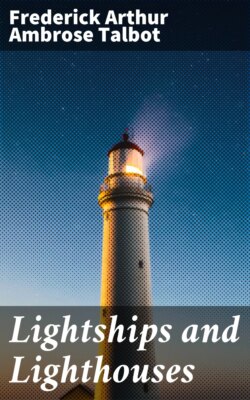Lightships and Lighthouses

Реклама. ООО «ЛитРес», ИНН: 7719571260.
Оглавление
Frederick Arthur Ambrose Talbot. Lightships and Lighthouses
Lightships and Lighthouses
Table of Contents
CHAPTER I. THE ORIGIN OF THE LIGHTHOUSE
CHAPTER II. BUILDING A LIGHTHOUSE
CHAPTER III. THE LIGHT AND ILLUMINANTS
CHAPTER IV. FOG-SIGNALS
CHAPTER V. THE EDDYSTONE LIGHTHOUSE
CHAPTER VI. SOME FAMOUS LIGHTS OF ENGLAND
CHAPTER VII. THE BELL ROCK AND SKERRYVORE LIGHTS
CHAPTER VIII. THE LONELY LIGHTS OF SCOTLAND
CHAPTER IX. THE FASTNET, THE OUTPOST OF EUROPE
CHAPTER X. LIGHTHOUSES BUILT ON SAND
CHAPTER XI. SOME LIGHT PATROLS OF THE FRENCH COAST
CHAPTER XII. THE GUARDIAN LIGHTS OF CANADA’S COAST
CHAPTER XIII. THE MINOT’S LEDGE LIGHT
CHAPTER XIV. THE TILLAMOOK ROCK LIGHT-STATION
CHAPTER XV. THE COAST LIGHTS OF THE UNITED STATES
CHAPTER XVI. THE LAMP-POSTS OF THE GREAT LAKES OF NORTH AMERICA
CHAPTER XVII. THE MOST POWERFUL ELECTRIC LIGHTHOUSES OF THE WORLD
CHAPTER XVIII. SOME LIGHTHOUSES IN AUSTRALIAN WATERS
CHAPTER XIX. THE SIGNPOSTS OF THE SANDBANKS
CHAPTER XX. A FLAMING SENTINEL OF THE MALACCA STRAITS
CHAPTER XXI. UNATTENDED LIGHTHOUSES
CHAPTER XXII. FLOATING LIGHTHOUSES
CHAPTER XXIII. THE LIGHT-KEEPER AND HIS LIFE
INDEX
Отрывок из книги
Frederick Arthur Ambrose Talbot
Published by Good Press, 2019
.....
The base was completed in a single year, and in 1876 the erection of the tower proper was commenced, together with the completion of the approaching stairway leading from the water-level to the base of the structure. The latter, divided into seven stories, rises in the form of a slender cone, tapering from a diameter of 21½ feet at the bottom to 16½ feet at the top beneath the lantern. Some idea of the massive character of the work which was demanded in order to resist the intense fury of the waves may be realized when it is mentioned that the wall at the first and second floors is 5½ feet in thickness, leaving a diameter of 10 feet for the apartment on the first floor, which is devoted to the storage of water, and of 7 feet for that on the second floor, which contains the oil reservoirs for the lamps. The living-rooms have a diameter of 11 feet, this increased space being obtained by reducing the thickness of the wall to 2½ feet. The erection of the superstructure went forward steadily, five years being occupied in carrying the masonry from the base to the lantern gallery, so that in 1881 for the first time powerful warning was given of a danger dreaded, and often unavoidable, from the time when ships first sailed these seas. Fifteen years’ labour and peril on the part of the engineers and their assistants were crowned with success.
Whereas the Ar-men light off Cape Finisterre demanded fifteen years for its completion, the construction of the Beachy Head lighthouse off the South of England coast was completed within a few months. It is true that the conditions were vastly dissimilar, but the Sussex shore is exposed to the full brunt of the south-westerly and south-easterly gales. This lighthouse thrusts its slender lines from the water, its foundations being sunk into the chalk bed of the Channel, 550 feet from the base of the towering white cliffs, which constitute a striking background. This beacon was brought into service in 1902, its construction having occupied about two years. The light formerly was placed on the crown of the precipice behind, but, being then some 285 feet above the water, was far from being satisfactory, as its rays were frequently blotted out by the ruffle of mist which gathers around Beachy Head on the approach of evening.
.....